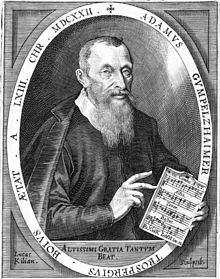Adam Gumpelzhaimer


Adam Gumpelzhaimer (also: Gumpeltzhaimer ; * 1559 in Trostberg ; † November 3, 1625 in Augsburg ) was a German composer, music teacher and music theorist.
Life
Gumpelzhaimer was first sent by his grandfather Michael to Oettingen , then to the Benedictine monastery of Sankt Ulrich and Afra Augsburg , where he received his first musical instruction from Jodocus Entzenmüller, the father of Joachim Enzmilner, who was successful in Upper and Lower Austria and who later became Baron and Count of Windhag , and probably also learned from the choir director Johannes Treer. In 1581 he became cantor and praeceptor at the high school near St. Anna . He kept this position until the end of his life. In 1582 Gumpelzhaimer enrolled at the University of Ingolstadt ; where and when he obtained his master’s degree is unknown. The marriage with Barbara Wismüller in 1585 did not result in any children. In 1590 both became citizens of Augsburg.
In 1596 Gumpelzhaimer reorganized the school choir at St. Anna. In 1606 he turned down an offer that would make him court composer and conductor of the Württemberger court orchestra. Over the years, Gumpelzhaimer was granted several salary increases. Nevertheless, towards the end of his life he got into financial difficulties. From 1617 to 1621 he suffered from a serious illness. The Gumpelzhaimer couple died of the plague a few years later.
In his place of birth Trostberg (Upper Bavaria) no baptism registers or similar documents have been preserved. One room of the local city museum is dedicated to Gumpelzhaimer and bears his name; the furnishings in it date from the first half of the 17th century.
In Hohenaschau Castle, depictions of the Nine Muses are installed in the coffered ceiling of a corner room. Different instruments of time can be seen in each picture; each muse holds a sheet of music on which the letter combination AG or AGT or AGTB can be read. It is an abbreviation of Gumpelzhaimer's initials, with the addition T (rospergius) B (oius or Bavarus), the Bavarian from Trostberg, as it can also be found in some of his printed works. On his portrait (engraving by Lucas Kilian 1622) there is a different reading of the four letters, namely the somewhat bumpy Latin sentence: A (ltissimi) G (ratia) T (antum) B (eat). The sheet music presented in Hohenaschau, however, does not make any meaningful compositions, is therefore purely ornamental and should be understood as a tribute to the music theorist Gumpelzhaimer, whose text Compendium musicae had 15 editions up to 1681.
plant
During his lifetime, Gumpelzhaimer was best known for his instructions Compendium musicae , aimed at his students , which were published in 13 editions for over 90 years. It is based on the Compendiolum musicae published by Heinrich Faber in 1548 and its translation, which Gumpelzhaimer expanded with numerous musical examples. Furthermore, polyphonic vocal works by Gumpelzhaimer have survived in various music collections.
Printing units:
All works were printed in Augsburg.
- 1591: Compendium musicae
- (further editions 1595, 1600, 1605, 1611, 1616, 1618, 1625, 1632, 1636, 1646, 1655, 1665, 1675, 1681) ( digitized version of the Augsburg 1595 edition in the Google book search)
- Neüe Teütsche Spiritual Songs, [...] in the style of the Welschen Villanellen, (2nd edition 1602)
- 1594: Neüe Teütsche Spiritual Songs, in the style of the Welschen Canzonen, (2nd edition 1602)
- 1595: Contrapunctus quatuor & quinque vocum
- 1601: Sacrorum concentuum Octonis vocibus modulandorum Liber Primus.
- 1604: Psalmus LI Octo vocum, (further edition 1619)
- 1611: Lustgaertlins Teutsch and Latin Spiritual Songs, First Part.
- (3rd edition of the Neüe Teütsche Spiritual Songs from 1591)
- Lustgaertlins Teutsch and Latin Spiritual Songs, Ander Theil.
- 1614: Sacrorum concentuum Octonis vocibus modulandorum Liber Secundus.
- 1618: Two beautiful Weihenaecht songs
- 1619: Lustgaertlins… First Part, (4th edition from 1591)
- Lustgaertlins… Ander Theil, (2nd edition from 1611)
- Wirtzgaertlin's Teütsch and Latin Spiritual Songs, First Part.
- (3rd edition of the Neüe Teütsche Spiritual Songs from 1591)
- Wirtzgaertlins Teütsch and Latin Spiritual Songs, Ander Theil.
Handwritten autographs:
- 1599: Codex Gumpelzhaimer
- 1624: Codex Gumpelzhaimer
Various part books are located in the former episcopal (Proskeschen) library in Regensburg.
literature
- Adam Adrio : Gumpelzhaimer, Adam. In: Music in the past and present . 1st ed. By Friedrich Blume. Bärenreiter, Kassel 1949–1986
- Richard Charteris: Adam Gumpelzhaimer's little-known score books in Berlin and Kraków (Musicological studies & documents 48), (American Institute of Musicology) Neuhausen 1996
- Adam Gumpelzhaimer, Monuments of Tonkunst in Bayern Vol. 19, Volume X Vol. 2, ed. v. Otto Mayr., Munich 1909/10
- William E. Hettrick: Gumpelzhaimer, Adam. In: The New Grove Dictionary of Music and Musicians . 2nd ed. Edited by Stanley Sadie and John Tyrrell. Oxford University Press, 2001, ISBN 978-0-19-517067-2
- Robert Münster: The Muses of Hohenaschau make music by Adam Gumpelzhaimer , in: Schönere Heimat Heft 4/2007 (Bayerischer Landesverein für Heimatpflege), p. 210 ff.
- Moriz Fürstenau: Gumpeltzhaimer, Adam . In: Allgemeine Deutsche Biographie (ADB). Volume 10, Duncker & Humblot, Leipzig 1879, p. 119 f.
- Franz Krautwurst : Gumpel (t) zhaimer, Adam. In: New German Biography (NDB). Volume 7, Duncker & Humblot, Berlin 1966, ISBN 3-428-00188-5 , p. 305 f. ( Digitized version ).
Web links
- Works by and about Adam Gumpelzhaimer in the catalog of the German National Library
- Sheet music and audio files by Adam Gumpelzhaimer in the International Music Score Library Project
- Sheet music in the public domain by Adam Gumpelzhaimer in the Choral Public Domain Library - ChoralWiki (English)
| personal data | |
|---|---|
| SURNAME | Gumpelzhaimer, Adam |
| ALTERNATIVE NAMES | Gumpeltzhaimer, Adam |
| BRIEF DESCRIPTION | German composer, music teacher and theorist |
| DATE OF BIRTH | 1559 |
| PLACE OF BIRTH | Trostberg |
| DATE OF DEATH | November 3, 1625 |
| Place of death | augsburg |